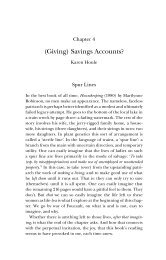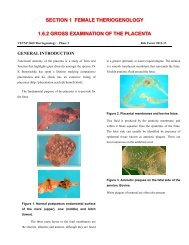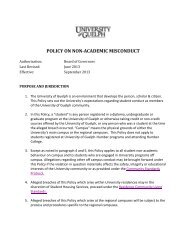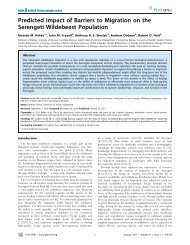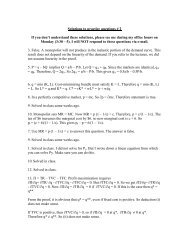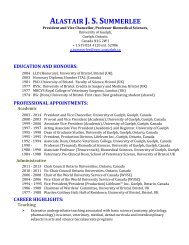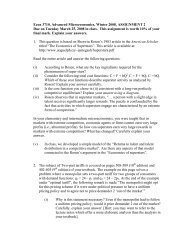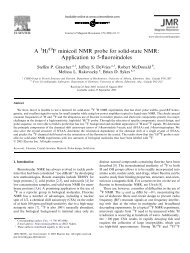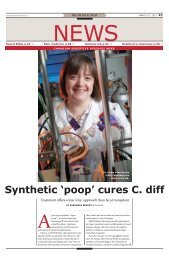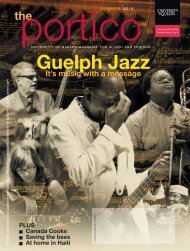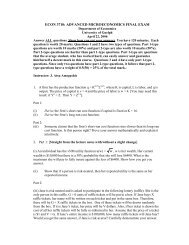You also want an ePaper? Increase the reach of your titles
YUMPU automatically turns print PDFs into web optimized ePapers that Google loves.
Human Movement•Is not due to genetic imprinting•It must be LEARNED•Neural pathways are establishedearly on•These pathways may be alteredthroughout lifetime
Proprioception‣Difficulty with interpretation –Sherrington, 1906‣Now called Sensorimotor System
…continued‣ learns from mistakes: specific movementscan be corrected so that they are properlyorchestrated to fit into a planned action‣ more nerve cells than rest of NervousSystem combined‣ sends information along fastest ascendingtract fibers of the Nervous System
Sensory Information1. Peripheral mechanoreceptors• Relied upon by healthy individuals2. Visual receptors3. Auditory/vestibular receptors
Areas of Afferent Flow‣ Sole of feet‣ Deep neck extensors‣ Sacrum or SI joint position
Goals of TreatmentAchieve best-Movement Pattern-Maximum Prevention1. Normalize peripheral structure2. Improve muscle balance3. Achieve automatized movementcontrol and good movement pattern
Normalize PeripheralStructure‣ Quality of movement dependent onperipheral information‣ Proprioceptive information causescortex to develop new patterns,therefore joints and muscles are the“PERIPHERAL BRAIN”
Muscle Imbalance‣ Change inequality of musclefunction due to altered biomechanics,recurrence of joint dysfunction‣Tight muscles activated when shouldbe silent‣ Change in movement pattern
Balance‣Most important factor in movementstrategies of closed kinetic chain‣Essential for athletic performance -needeffective & efficient movement strategies‣Integration: -neurological sensory info-muscular co-ordination-biomechanics
Central Nervous System‣ Improve Neural Control/FiringPattern toprevent recurrence‣ Increase proprioceptive flow (periphery)(CABOT - afferent PNF)‣ Facilitate postural structures - primitivelocomotion‣ Speed up contraction- decrease injury
Lower Extremity Injury‣ Inhibitory effect on proprioception-altered neural code to CNSShown by : Deficits in balanceLatency of firing
Joint Dysfunction and MuscleCorrelatione.g. Knee PathologyIncreased tone - Vastus lateralis- Rectus femoris- HamstringDecreased tone -VMO
S/I Dysfunction- same side: increase tone - iliopsoas, piriformisdecrease tone- glut max- contralateral: decrease - glut min/medincrease - lower rectus abdAllows: lateral pelvic shift decreased acetabular activity
Clinical Importance ofMuscle ImbalanceUpper Crossed SyndromeDistal or Pelvic Crossed Syndrome
ILIOPSOAS- two totally distinct functionsILIACUS-pulls pelvis forward-If alone,pulls L.Sp. Into extension-neutralized by psoas-buttress effectPSOAS-acts purely as a hip flexor-not activated by spinal stabilization-implants not activated inflexion,extension,rotation or lateral bending
ILIOPSOAS
Movement Patterns‣ Need to be assessed early(most N.B)‣ Poor patterns influence posture andmotor control‣ Correct M.P.facilitated by a specificafferente.g. walking –dorsiflex big toeflex finger –flex elbow and shouldereye movement- followed by trunk
Movement Patterns1. Upper unit of neck/shoulder/arm‣shoulder abduction‣ neck flexion‣push-up2. Hip movement and abdominals‣hip abduction‣hip extension‣abdominal curl
Tensegrity Model• Less Stiff• More resilient• Load one area, and the rest will give toaccommodate• Increase load, increase strength of structure
Myers Model• Myofascial meridians along continual bands• Strain runs from bone to bone• Muscle attachments
Secondary Curves• Formed or developed• 1 st Cervical (head movement)• 2 nd Lumbar(crawling)• 3 rd Posterior knee(standing)• 4 th Arch of the foot(walking)• Depends on muscle balance –to form--to maintain
Secondary Curves• All related to each other• Strain runs up & down fascial meridians• Any change asserts a compensatory patterninto another secondary curve
Superficial Back Line (SBL)• Links posterior aspects of these linestogether• Posturally supports body in full extension• Prevents the tendency to curl in flexion• Slow twitch• In movement creates extension except inknee and plantar flexion
Spiral Lines• Foot arches to pelvic angle• Involved in knee tracking• Involved in SI functions• Connects at ASIS
Upper Part• Serape Effect• SantanaLower Part• Sling mechanism• Peronei and tibialisanterior
Rotating hips and shoulders in oppositedirections causes the trunks ventralmusculature to pre-stretch in a diagonalpattern.
Sling Mechanism• Both attach to tissue that spans the 1 stmetatarsal to the 1 st cuneiform.• Peronei wraps around the cuboid• Peronei tend to shorten• Tibialis anterior tends to lengthen• Leads to hyperpronation• If reverse - Supinated
The Spiral Line
• Hip & Foot can affect each other• Anterior pelvic tilt decreases tension onTibialis Anterior Reduced Arch• Posterior Pelvis creates inverted foot(supin)• Spiral Line also effects patellar tracking
Co-contractionof Tibialis Anteriorand Peroneus Longus
Functional Lines• Minimal postural support• Athletic endeavors• Stabilizing postures outside theresting/standing position• Seen in– Yoga– Throwing a ball– Kicking a ball• Linked across the body diagonally
Kinetic chainHipKneeAnkle
• Medial arch (toe foot)• Lateral arch (heel foot)Foot• Toe Foot– MT 1-3 > Talus > Tibia > Femur– Proper mechanics• Heel Foot– MT 4&5 > Fibula > Bicep Femoris > Ischial Tuberosity– Involved in chronic S/I
Optimal Arch ApexAdd.Hall, F.H.L.Fl.D.M.Abd dig.min./hallFl. Dig Brev
Posterior Tibialis
Flexor Hallicus Longus
Soleus
Gastrocnemius
Toe Flexor Stretch
Foot Orthoses• Foot orthoses are often applied to the medial side of theshoe to support the medial arch of the foot• Studies analyzing their effectiveness have had positiveresults in 70-80% of subjects• Other studies on custom molded orthotics report 50-90%success• This is astounding considering the myriad of shapes,placement and construction materials used• Due to a lack of consistent application criteria the reasonfor their effectiveness is still a mystery
•Stacoff et al (2000)speculate that theeffects produced by theorthotics is due tomechanical and/orproprioceptivemechanisms
Proprioception• Orthotics are thought to increase the afferentfeedback from cutaneous receptors in the foot(Stacoff 2000)• This is assumed to change the innervation patternand subsequent movement pattern• Difficult to determine the actual mechanism due tothe complex soft tissue and joint input necessaryfor movement
Mechanical• Several studies have found small and frequently nonsignificantdifferences in kinematic variables whencomparing various orthotic conditions• As a result, reducing foot eversion and tibial rotation maynot be the primary function of orthotics• In a recent study, knee joint moments may be substantiallyaltered when using posted orthotics when running• Another author speculated that inversion moments at theankle joint may be related to excess foot eversion and thiscould be the mechanism affected with orthotics
Mechanical• In a study of posted and molded orthotics, posting wasfound to reduce max foot eversion, and ankle inversionmoment while increasing vertical loading rate and maxknee external rotation moment• Molding and posting and molding was found to reducevertical loading rate, and ankle inversion moment andincreased max foot inversion and max knee externalrotation moment• In another study on the effect of medially placed orthoticson tibiocalcaneal movement measured with bone pins, theorthotics did not change the movement during stance phase
Barefoot Science• Barefoot Science is a progressive systemdesigned to facilitate muscular stability ofthe foot• in an article in Biomechanics (2001) theauthors report:• “The results indicate a significant beneficial impact on the adaptivemuscle-firing sequences required to stabilize the foot structure prior toand during full weight bearing as well as toe-off.”
• Multidirectional activitiesThe Foot Strengthening SystemNeuromuscular StimulatorStimulus is always centeredunder Optimal Arch Apex:• Standing• Walking/running
The Foot Strengthening SystemNeuromuscular StimulatorStimulus triggers reflex muscle activations that facilitate the WindlassEffect/cuboid pulley effect (i.e., Optimal Arch Apex):• Standing - dynamic• Walking/running - impact moderating/pre-adaptive• Multidirectional activities - impact moderating/pre-adaptiveFigure 1Figure 2
Take Home Message• The application of orthotics without thetreatment and correction of kinetic chaindysfunction seems negligent on our part• May just delay the return of symptoms• Difficulty as a practitioner in deciding whento use orthotics and what type to prescribeor recommend• Very few studies to base your decisions on
FUNCTIONAL TESTING
Specific SensorimotorTraining• Can help fine-tune afferent-efferent arcs• Re-train learned motor patterns• Increase reflexes to sudden change inposition
CORE STABILITYAbdominal routines that make your absburn do not necessarily train your core.It just helps you get really good at anexercise while lying on your back!!
STRETCHESPiriformisITB
Hip Flexor
POINTS TO REMEMBERActive Warm-up
Single Leg Balance-unsupported leg -45 0 Hip Flexion-90 0 Knee Flexion- arms relaxed at side - can reach out for balanceTo increase Difficulty- close eyes- stability trainerProgress to next level of difficulty after- 10 seconds X 6 repeats X 2/day
Single Leg Balance
Normative Data for Single-Leg StandingBalance Test – Eyes Closed (Bohannon 1984)Age (years)Eyes Closed (seconds)20 – 49 24.2 – 28.850 – 59 21.060 – 69 10.270 – 79 4.3
Beam Exercise‣ Maintain proper postureverbal instructions1. Head up, chin tucked in, ears over shoulders2. Pull shoulder blades down and together3. Pull lower abdominals in and up4. Tighten gluteal/buttock muscles5. Look straight ahead, not at feet or beam6. Avoid using your arms to balance
Beam ExercisesExternal RotationCross-over
Gluteal Activation
Cool Walk
Walking A’s
FUNCTIONAL TESTINGDouble Leg Squat
Single Leg Lunge
MULTIDIRECTIONAL TRAINING1.V_Lunge2.Hop Scotch
Roller StoolForwards/BackwardsSideways
Ball Rotations
Complex Movements• Split squat• One legged squat
Complex Movements• Lateral slide with cable
Complex Movements• Lateral Bar Toss
Push Ups - SpidermanSpider ManPush Upspart 1SpiderMan PushUps part 25 strides each(walk forward)
Zig Zag Ball on Bosu
Athens 100 meter finish



